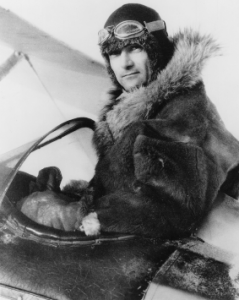In 1913, a group of Fairbanks merchants shipped an airplane from Seattle to Fairbanks via steamboat. A pair of Lower 48 barnstormers flew the biplane 200 feet above Weeks Field, putting along at 45 miles per hour. The merchants sold tickets to the show: The flight was considered nothing more than a spectacle.
Those Alaskans had no concept of how the technology of air would completely alter life on the ground. Today Alaskans fly 30 times more per capita than other U.S. citizens, partially because about 80 percent of Alaska is not accessible by road. In the Alaska Bush, people still greet airplanes, anxiously awaiting mail, fresh food and a glimpse of the pilot. Air traffic is at the center of the state’s economy and lifestyle, whether it’s a commercial airline delivering cargo, the U.S. Air Force moving a family to Anchorage, or a flightseeing service offering tours of Mount McKinley.

On the 100th anniversary of that historic 1913 flight, the Anchorage Museum opens “Arctic Flight: A Century of Alaska Aviation.” This exhibition, on view Feb. 9 through Aug. 11, tells compelling stories of survival, adventure and ingenuity. The exhibition is co-curated by the Smithsonian Institution’s National Air and Space Museum and features objects from the Smithsonian and several Alaska museums, including the Alaska Aviation Museum and Pioneer Air Museum.
Historical artifacts, video and photographs reveal the state’s remarkable aviation history, with special focus on the pioneer bush pilot era. From their open-air cockpits, Alaska’s first pilots faced some of the planet’s most inhospitable weather and challenging terrain without maps or accurate weather information. Their airplanes broke the isolation of communities previously accessible only by boat in summer or by dog team in winter. Bush pilots became conquerors in the air and heroes on the ground.
“Arctic Flight” artifacts include wreckage from the Will Rogers/Wiley Post crash of 1935, a military-issued electric flight jacket from World War II, and the exhibition’s centerpiece, a Stearman C2B biplane brought to Alaska in 1928. This plane, on loan from the Alaska Aviation Museum, was flown by several legendary Alaska bush pilots including Joe Crosson, the first pilot to land on Mount McKinley, and Noel Wien, founder of the state’s first airline. Film footage includes a 1927 clip from the first airplane to fly over the North Pole, as well as newsreels from the World War II campaign in the Aleutian Islands.
This exhibition also looks at the modern aviation industry and what it’s like to be an Alaskan bush pilot today. Children can play pilot in a replica antique cockpit and conduct experiments that explain the physics of flight. “Arctic Flight” demonstrates how, in just 100 years, airplanes have evolved from frivolous spectacle to crucial part of the Alaska way of life.
Tickets are included with museum general admission: $12 adult, $9 student/senior/military, $7 child, free age 2 and younger. Learn more and buy tickets at anchoragemuseum.org.
The Anchorage Museum is the largest museum in Alaska and one of the top 10 mostvisited attractions in the state. The museum’s mission is to share and connect Alaska with the world through art, history and science.
Learn more online at www.anchoragemuseum.org.




